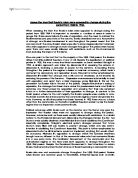Political advances within Russia such as the Zemstva and the Duma may give the impression that Russian rulers were not opposed to change during the period. However, advances such as these were usually followed with restrictions. In a similar fashion to the Provisional Government disbanding the Petrograd Soviet, the first two Duma’s were quickly dissolved under Nicholas II and Lenin abolished the Constituent Assembly completely. Stolypin’s electoral system changes ensured that future Duma’s were filled with pro Tsarists to prevent change, which was also Lenin’s intention in abolishing the Constituent Assembly. This point is further emphasised by Alexander II who for all his reforms, would not implement anything that would affect his autocracy. Nicholas II’s opposition to change which the October Manifesto brought was no different to that of the communist rulers who had converted Russia into a one party state. The totalitarian Government of the communists and the authoritarian regime of the Tsars were both opposed to change throughout the 1855-1964 period. Despite the Provisional Government’s best intentions to reform Russia, their removal ended the last chance of Russia becoming a democratic state.
Russia also saw vast economic change throughout the 1855-1964 period. Russian rulers shared one common goal, to industrialise. Influential figures such as Stalin, Count Witte and Stolypin had all sought to achieve this through different methods, however in contrast Alexander II, for all the reforms he brought to Russia, did little to industrialise the nation despite its need being expressed in war. This may emphasise the viewpoint that Russian rulers were not opposed to change as they sought to address the backwardness and fragile state of the economy. However this was not done with the intention to change Russia for the better - war was a vital agent of change in emphasising the need for Russia to industrialise. Much like defeat in the Russo Japanese war had forced Nicholas II’s hand, Stalin’s fear of Germany was an important catalyst for the 5 year plans and his desire to catch up with the West in 10 years. Lenin’s decision to switch to NEP in 1921 further emphasised the role war, not motivation to change Russia for the better, played in forcing Russian rulers to act as he had acted quickly to switch policy in order to maintain his autocracy, much as the Provisional Government had attempted previously in continuing an unpopular war. Neither regime wanted to see their influence lowered. Much like political concessions, economic change within Russia was largely highlighted by war and forced upon the regimes throughout the period.
Russian rulers throughout the period also saw the role that the peasantry had in needing to feed the Russian people and were reluctant to advocate vast changes. Lenin’s decision to send in the requisition squads to take supplies from the peasantry and the Redemption payments set up by Alexander II in the aftermath of the Emancipation Act both sought to maintain the status quo and further restrain economic change within Russia.
Throughout the period repression and censorship were important instruments of the state in maintaining the status quo. The view that Russian rulers were opposed to change throughout the period is supported by the continuing use of the secret police. Lenin’s Cheka had heavily intensified aspects of Tsarist repression used under the 3rd section and Okhrana, and the KGB would subsequently follow suit by infiltrating opposition groups intent on change. In contrast to the Tsars before them, the communists went one stage further and heavily used propaganda as a further restraint on change, the cult of Stalin were very influential as it had been under his predecessor Lenin. Censorship was also repeatedly tightened and reduced by Russian rulers, which provides further evidence of their opposition to change. Khrushchev reduced repression as Alexander II and Nicholas II had done before him, which can be argued to indicate some desire to change, however even with these reductions it was still very evident no matter what regime was in power as every aspect of Russian life was censored, from the media to the arts.
One can also point to the fact that throughout the period, social housing remained uniformly bleak. Under Tsarist rule, accommodation often consisted of a single, overcrowded room and little was done to change the appalling conditions. In contrast, both Khrushchev and Stalin adopted social housing programs in an attempt to improve the situation, however in both cases the accommodation was hastily built and of poor quality, which indicate that the communists shared the Tsarist opposition to change in their lack of interest to improve social conditions in the period.
It can be argued that policies such as collectivisation, emancipation and Stolypin’s agricultural reforms show Russian rulers were not entirely opposed to change. However, collectivisation was implemented through Stalin’s desire to modernise agriculture to benefit the 5 year plans, in much the same way as the effects of Emancipation had been reduced by redemption payments, as well as the land captains which Alexander III granted more powers to. Khrushchev may have shown a greater degree of intent in his attempts at reform, as Stolypin had done previously, however these were often ill planned and underfunded as much like Stolypin, who sought to maintain Tsarist autocracy, he concentrated his efforts elsewhere such as the Cold War. Russian rulers were opposed to change socially, as Alexander II’s acknowledgement that ‘’it is better to abolish serfdom from above, than to wait before it begins to abolish its self from below’’ perfectly sums up.
In conclusion, Russian rulers were opposed to change throughout the 1855-1964 period. Despite the advances within the period such as emancipation and industrialisation, these were often forced upon the rulers. When change was implemented, it was often followed up with restrictions such as the Fundamental Laws, the Mir and redemption payments and Stalin’s control over the workers.








